12 Great Cathedrals of Spain

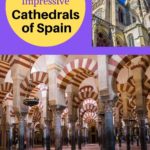


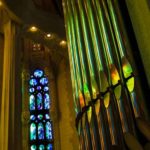
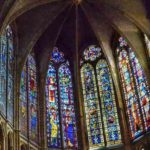
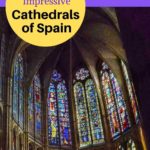

The scores of cathedrals and lesser churches have always occupied a special part of my affinity for Spain. For it is in these ostensible houses of God that you get a sense of the country’s history and school of thought, providing a basis for understanding the essence of Spain. You certainly won’t get a complete picture. You’ll have to look at Goya’s etchings in the Prado, spend lots of time in bars, see Flamenco and fútbol, and maybe take in a bullfight to get a more catholic (small c) impression.
But cathedrals are a good place to start, because, in a way, they are monuments to the variety of life that makes up Spain. Keep in mind that everyone from kings to cardinals and skilled masons to ditch diggers participated in their construction. And, that the result of their patronage and labor was the literal and figurative centerpiece of any city or town.
And, of course, the Cathedrals are the embodiment and repositories of spectacular artistic and engineering achievements. The interior details are limitless: from the architecture itself to cast metal screens that surround carved choirs; to saints sculpted in marble and wood or painted on plaster, canvas, and stained glass; to their shards housed in elaborate if dubious reliquaries. And, don’t forget the gargoyles and all the other pure whimsical elements of the exteriors.
This is the artistic spirit of Spain, spread to every province and every corner of the kingdom for anyone to see. You don’t have to go to the Prado to see all the best art in Spain.
Table of Contents
The Basilica of the Sagrada Familia in Barcelona
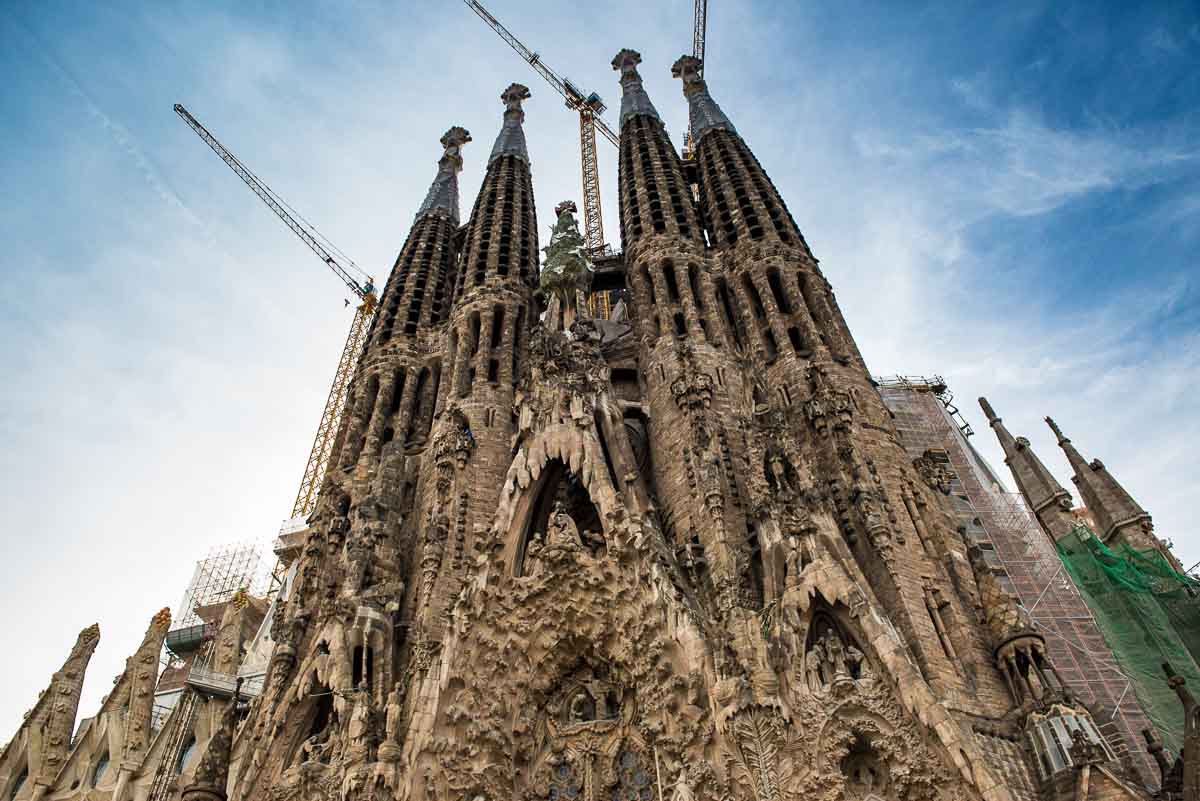
Words begin to fail when you are asked to sum up Antoni Gaudi’s Sagrada Familia in Barcelona. Perhaps the best thing to say is “it’s fantastic” in the literal sense of that word. Gaudi was a visionary who utterly changed architecture in the early 20th Century. The façade, which seems to drip off the structure, the incorporation of animals and vegetables in the decoration, the fanciful geometry of the interior columns, and finally, the color of the windows: all elements are inspired.
Gaudi’s design was not finished at his death, and unfortunately many of his models and plans were deliberately destroyed during the Spanish Civil War.
But the models have been mostly restored from the shards left on the floor, and the style has been honored and amplified by subsequent architects, sculptors, and glass artists. If you go, allow hours to see it. And remember to occasionally close your gaping mouth.
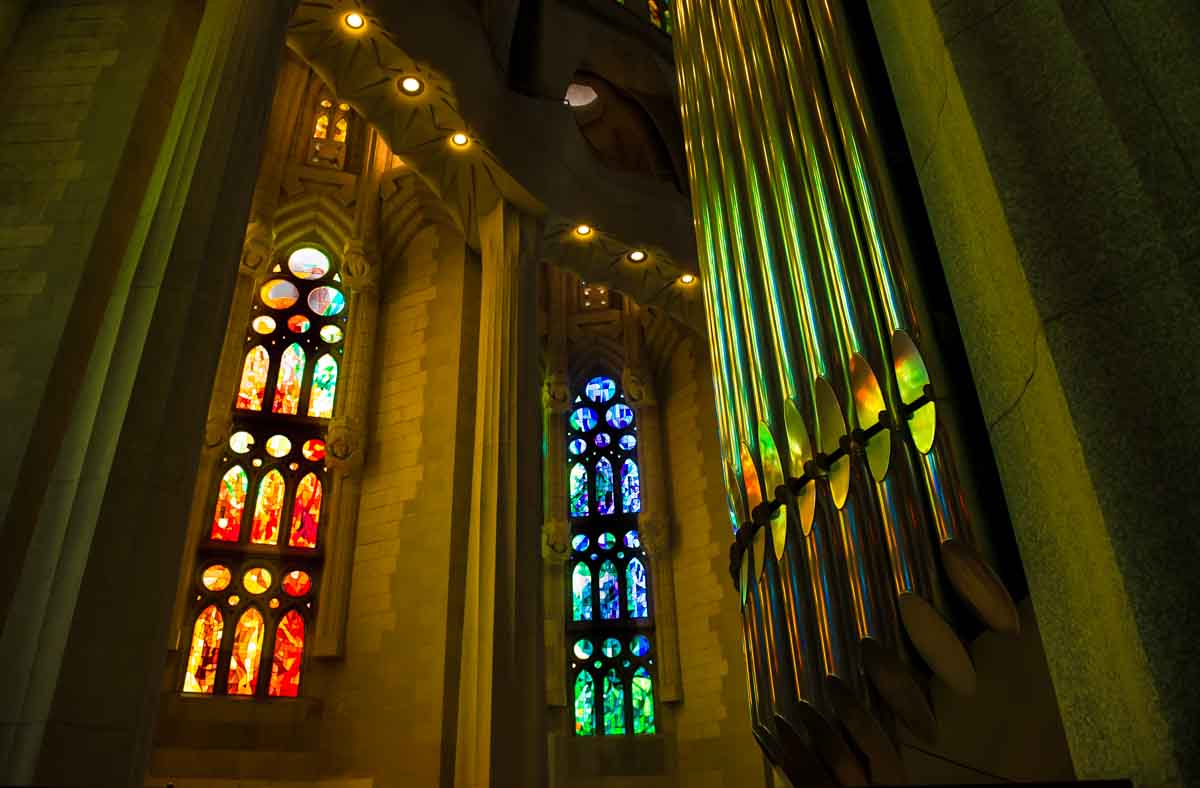
We first saw the Sagrada Familia in its comparatively incipient form when we first visited Spain in 1975. It’s come a long way since then, and is actually scheduled for completion in 2026. One should note, though, that there’s a saying in Spain when something is taking a very long time. It amounts to: “It’s taking longer than the Sagrada Familia.”
One tip for visiting the Sagrada Familia: make your reservations in advance for a timed entry. Otherwise, you’ll be standing in line for as much as a couple of hours. And, don’t begrudge the entry fee. That’s how their paying for this. (Update: as of April 2021, the Sagrada Familia is closed to the public due to Covid restrictions.)
The Gothic Cathedral of Barcelona
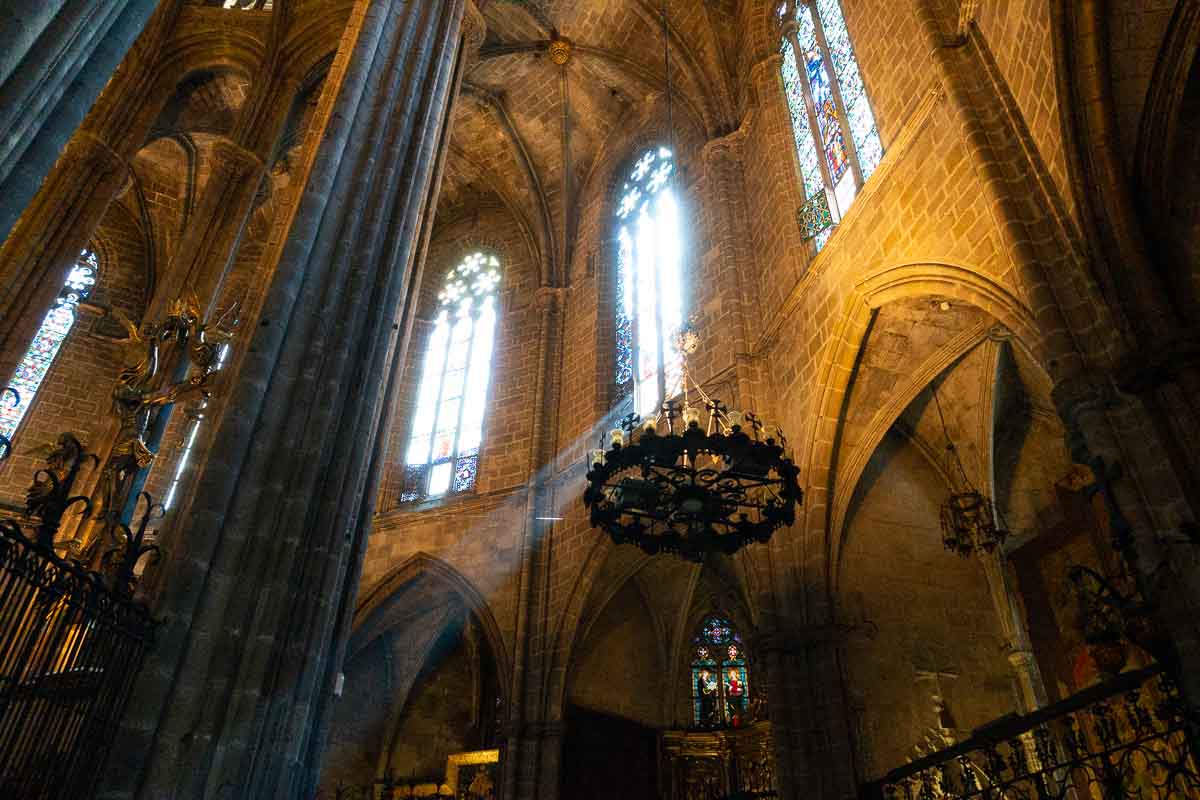
It probably should be mentioned that the actual Cathedral of Barcelona is the Gothic church in the old part of the city–the Barri Gòtic (in Catalan) or the Barrio Gótico in Castilian. The Sagrada Familia is a “mere” basilica. The Gothic Cathedral is the home church of the Bishop of Barcelona.
The cathedral was constructed from the thirteenth to fifteenth centuries, with the principal work done in the fourteenth century. In the late nineteenth century, the neo-Gothic façade was added over the original nondescript exterior.
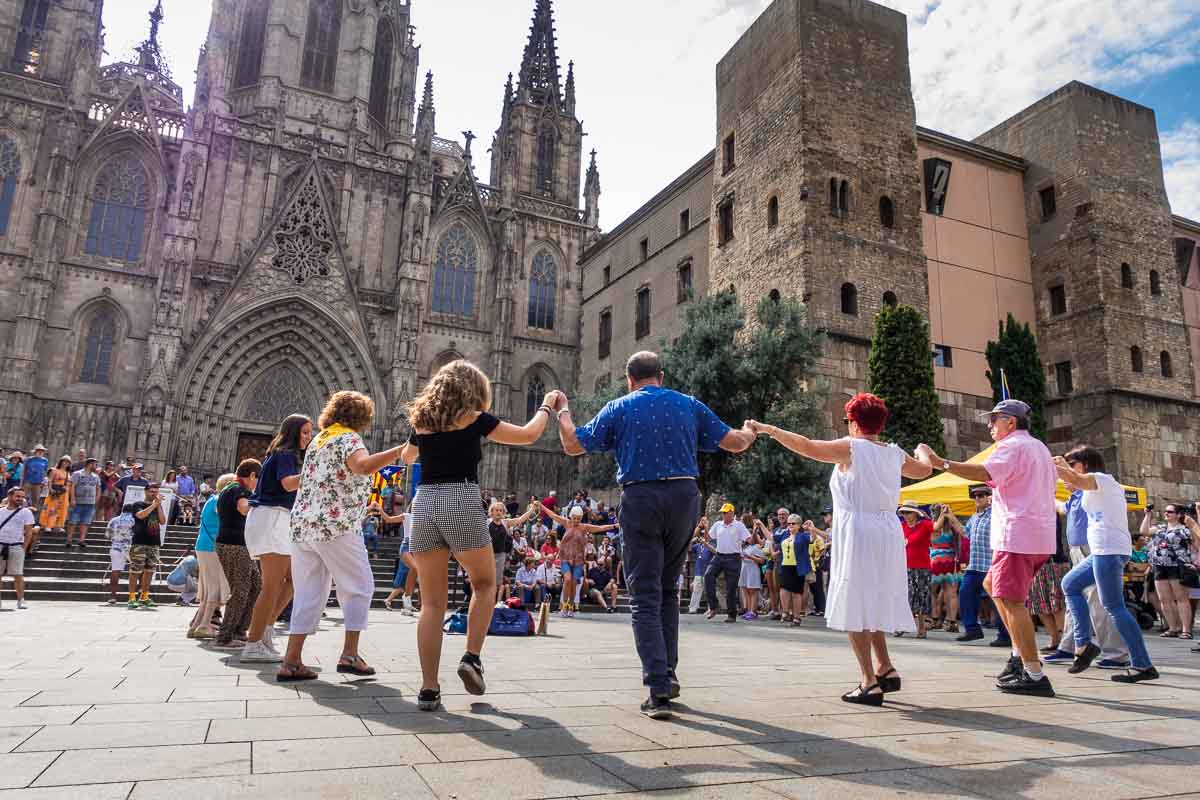
As Spanish Cathedrals go, the Barcelona Gothic Cathedral is rather ordinary in its decor, if one can say any cathedral is ordinary. But it does provide the backdrop for one of the most charming Catalan traditions, the Sunday gathering to dance the Sardana, the Catalan national folk dance and a ritual worth viewing at least once on your visit to Barcelona.
The Cathedral of Sevilla
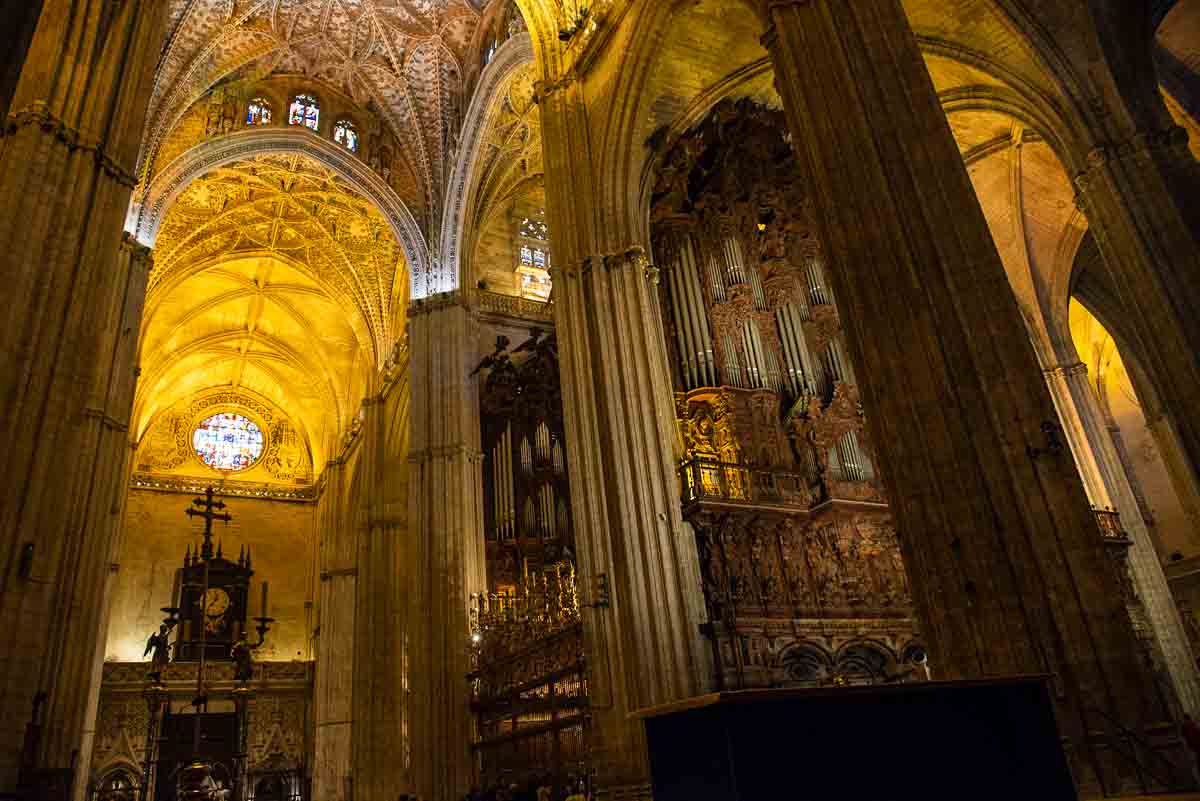
At the time of its completion in the early 16th Century, the Cathedral of Sevilla was the largest church in the world, at the time overtaking the Hagia Sophia of Istanbul. Today, it’s the fourth largest church, and still the largest in Spain.
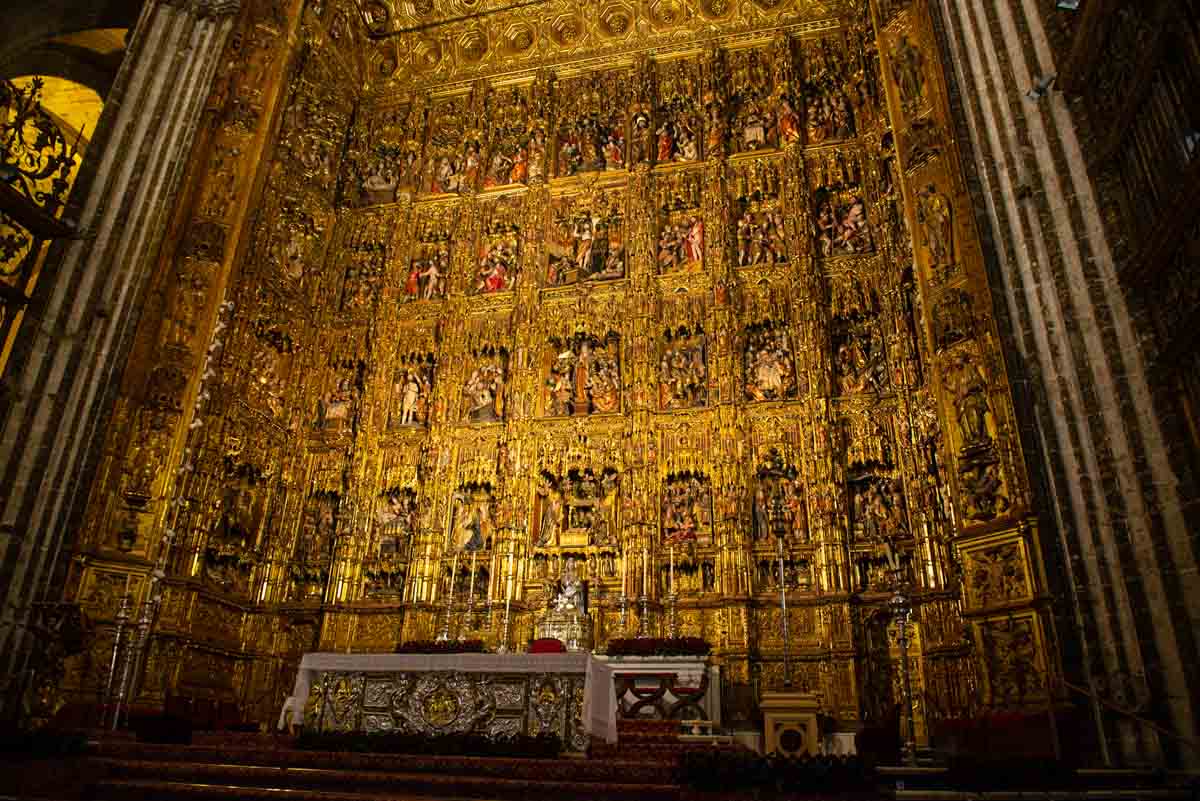
The Sevilla Cathedral, in addition to its size, has several distinguishing features. Of particular note is the enormous golden altar, and the choir that is flanked by two organs. As you gaze up at the organs, be sure to take note of the decoration on the ceiling. Gothic artistry at its highest expression.
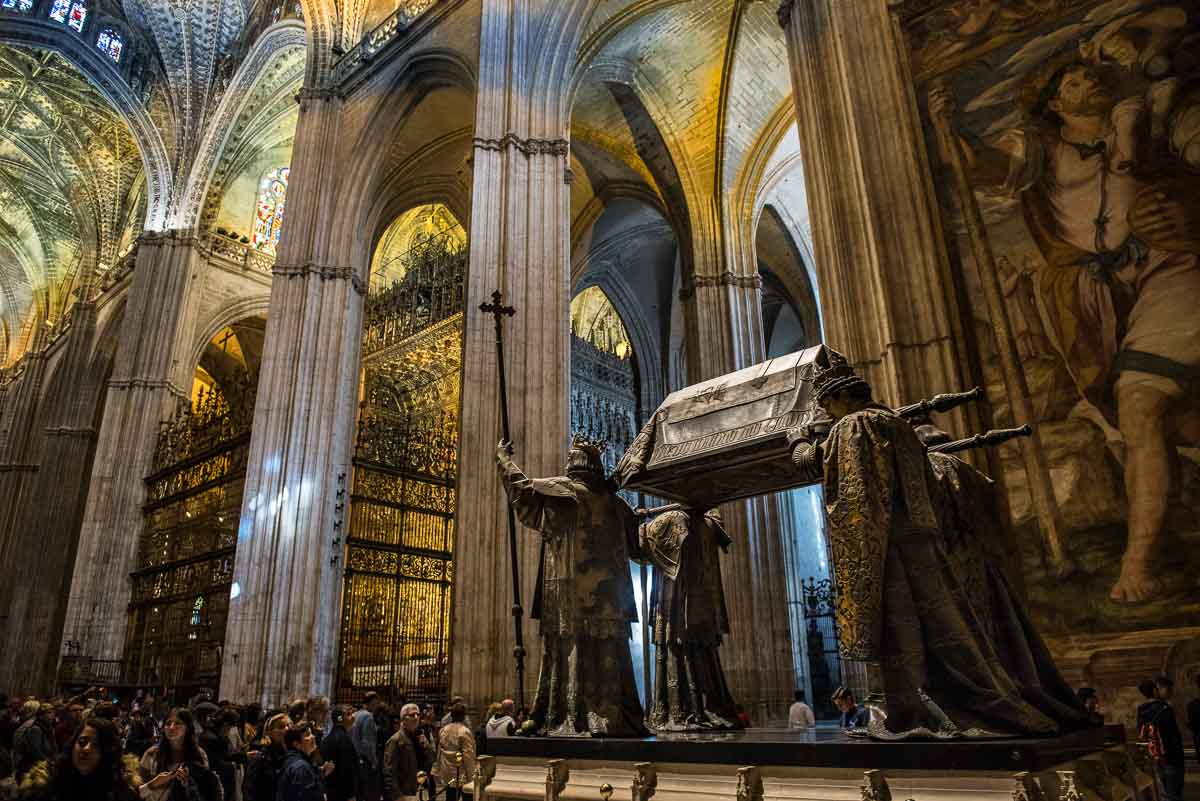
No matter what you might think of Christopher Columbus, or Cristobal Colón, as he’s known in Spain, you have to admit that he is perhaps the (non religious) person who most affected the history of the world–for good or bad.
The Cathedral of Sevilla hosts the tomb of Christopher Columbus. Or what is said to be his tomb after his remains were brought back from the New World. His grave his been around the world, so to speak. (The question of where Columbus is buried is still in dispute.)
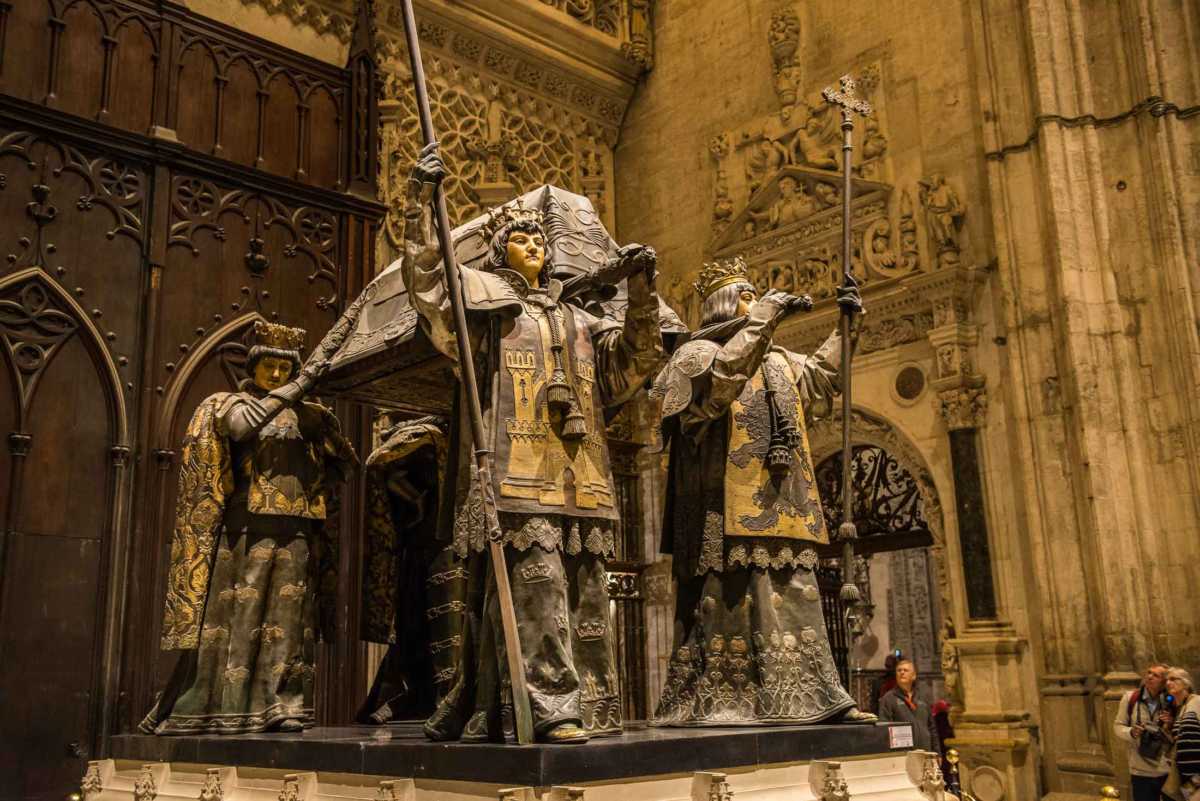
There is no dispute, though, about the catafalque itself. It’s a lovely piece of art. The tomb of Columbus is carried by figures representing the kings of the four regions of Spain: Castilla, Leon, Navarra, and Aragon. The coats of arms on the kings and the surroundings are also full of symbols that require a separate article to elaborate. I invite you to check that out for yourself.
The Cathedral of Burgos
Said by many to be the most beautiful Gothic cathedral in Spain, the Cathedral of Burgos was declared a UNESCO World Heritage Site in 1984. It is the only Spanish cathedral that has this distinction independently, without being joined to the historic center of a city.
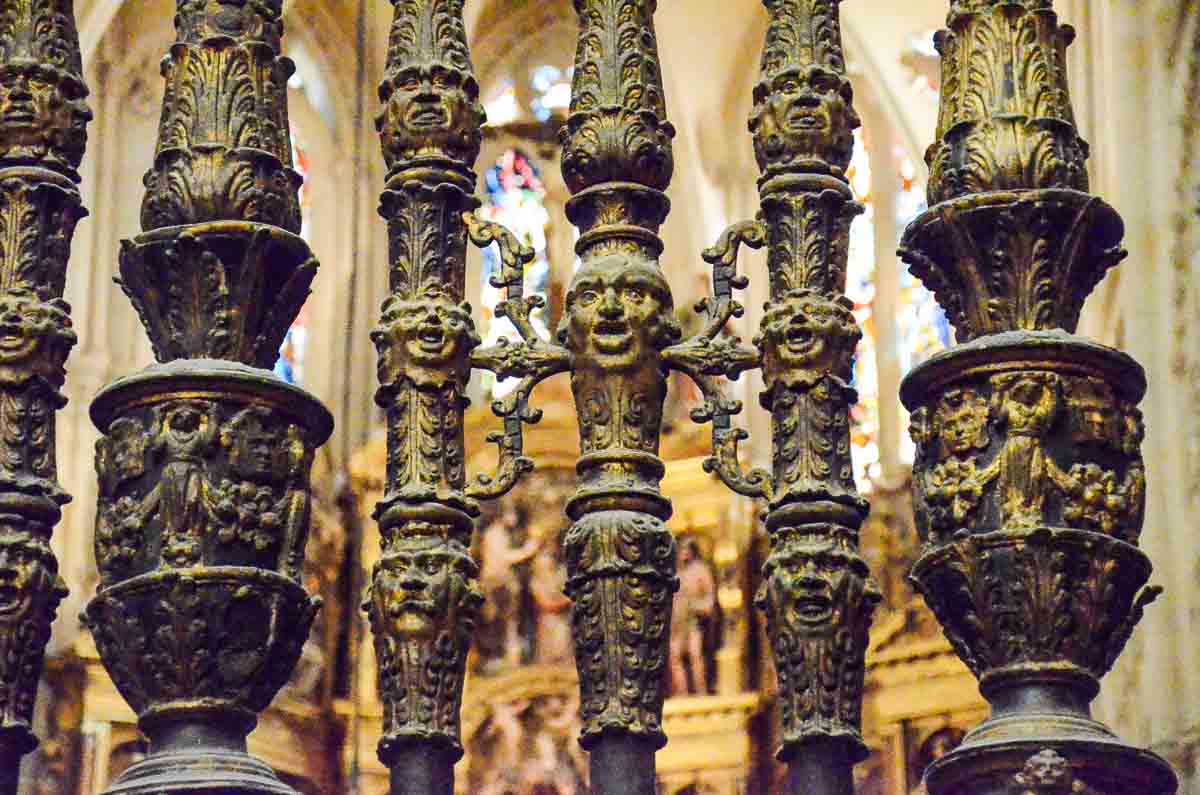
The French style of delicate and intricate stone work is particularly evident in the exterior of the Burgos Cathedral, and in the proliferation of exquisite detail such as the iron bars that surround the choir.
Another feature of the Burgos Cathedral worth noting is the tomb of El Cid and his wife Dona Ximena which lies directly under the dome. El Cid was one of the Christian heroes of the Reconquest of Spain from the Moors. There is an epic poem, the Cantar de mio Cid, which is the oldest preserved epic poem in the Spanish language. When we toured the Burgos Cathedral in the 1990s, we had the pleasure of running into the sacristan of the Cathedral, who joyfully recited passages from the poem as he showed our family around the church. Unfortunately, when we returned to Burgos many years later, he had died. But his own book of poetry about the Burgos Cathedral was available in the Cathedral gift shop.
The Mosque/Cathedral of Córdoba
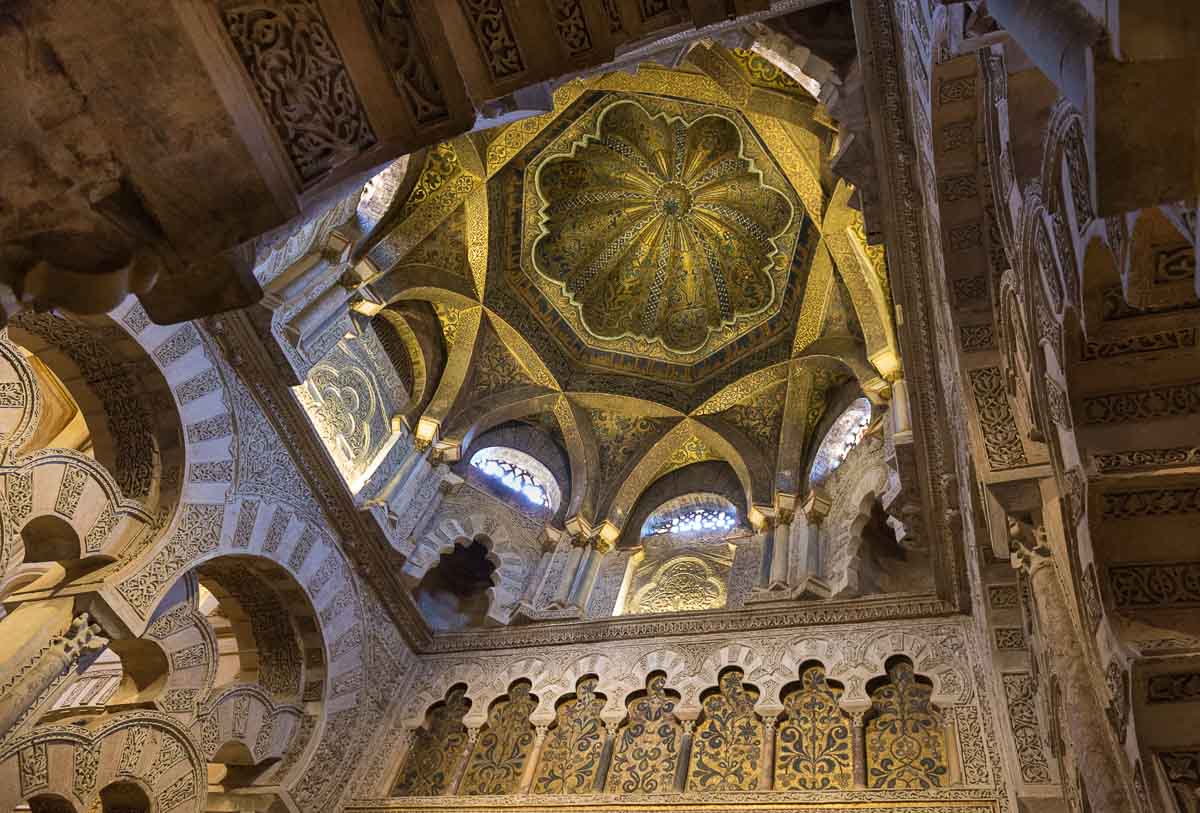
The Mezquita, or Mosque of Córdoba, is one of the real wonders of Spain. Along with the Alhambra of Granada and the Alcazar of Sevilla, it makes up the trifecta of Moorish architecture left over from when the Muslims controlled the Iberian peninsula.
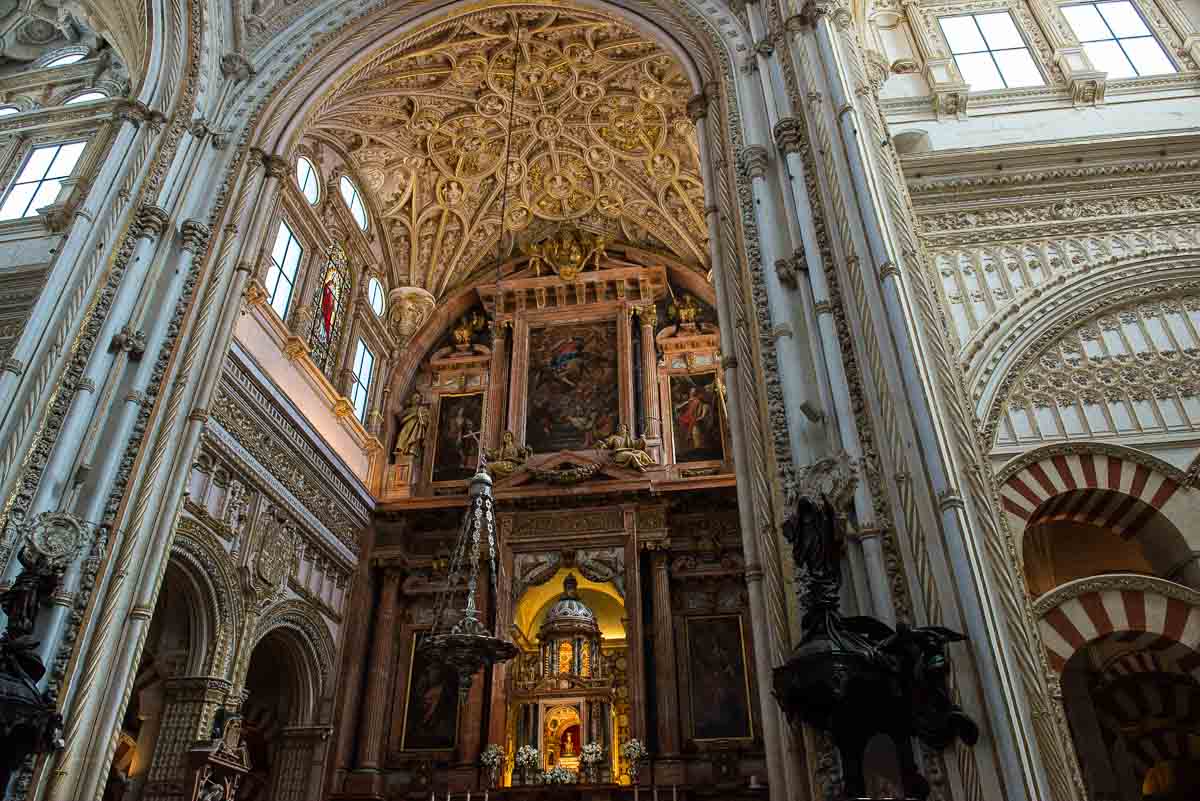
Regrettably, after the Reconquest of Córdoba by the Christian forces, the Christians eventually decided to repurpose the huge elegant mosque into a Christian cathedral, including filling in nearly all the niches around its interior walls with chapels and adding many sculptured scenes from the Christian stories as reliefs in the arches.
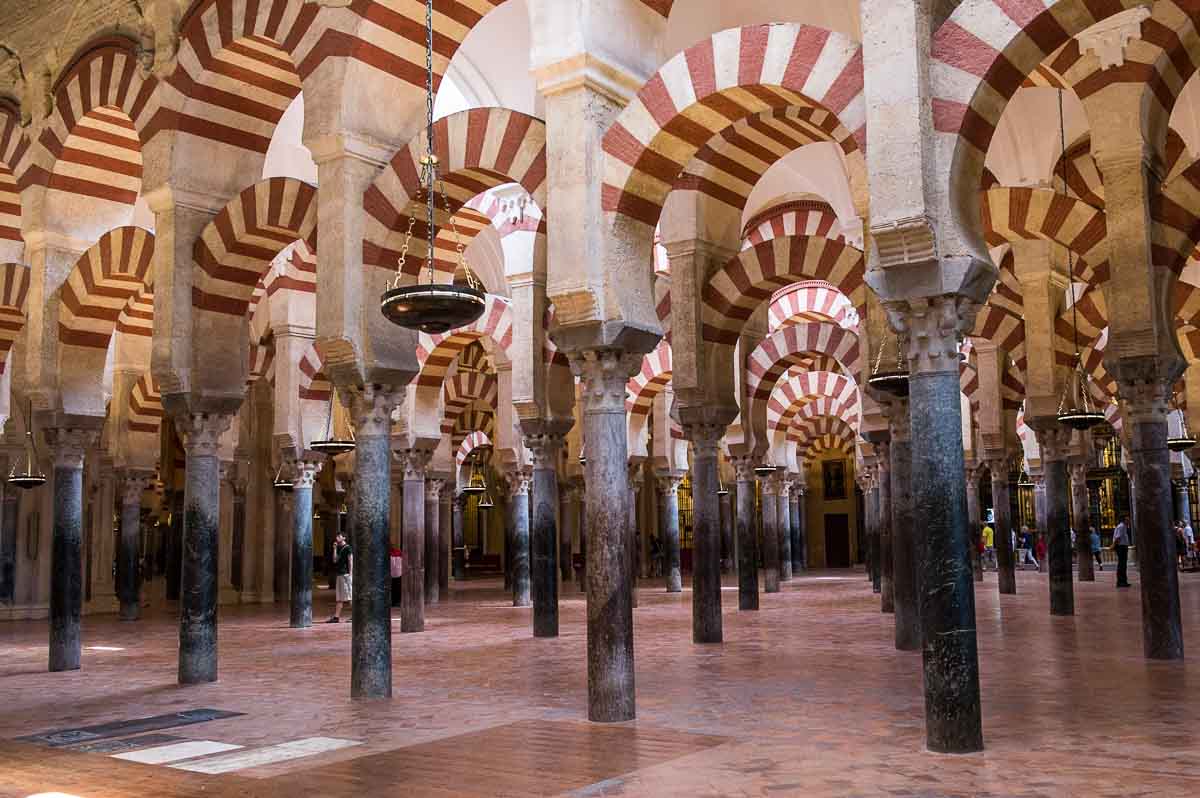
But, much of the original mosque was preserved and you can still gaze at the mihrab and the remaining geometric perfection of the arched aisles and give thanks to the cooler heads which kept them intact.
The New Cathedral of Salamanca
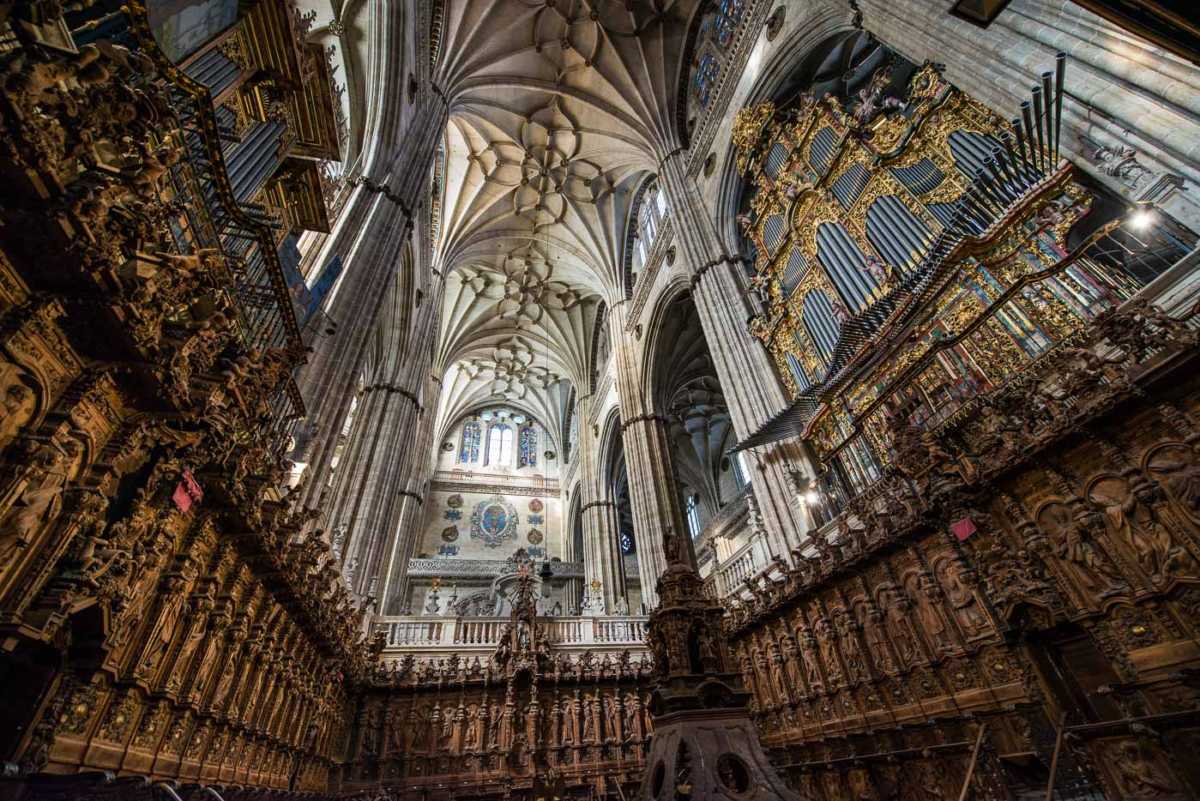
The “New” Cathedral of Salamanca is, as the name suggests, one of the newer massive cathedrals of Spain. Begun in the early 1500s, it was not consecrated until 1733, over 200 years later. It started out in a late Gothic style, with all the linear turrets and flourishes, but finished up as more of a Baroque exercise. So, in practical terms, that means the outside, except for the dome, is more in tune with the adjacent Old Cathedral while the interior is full-on decorous Baroque.
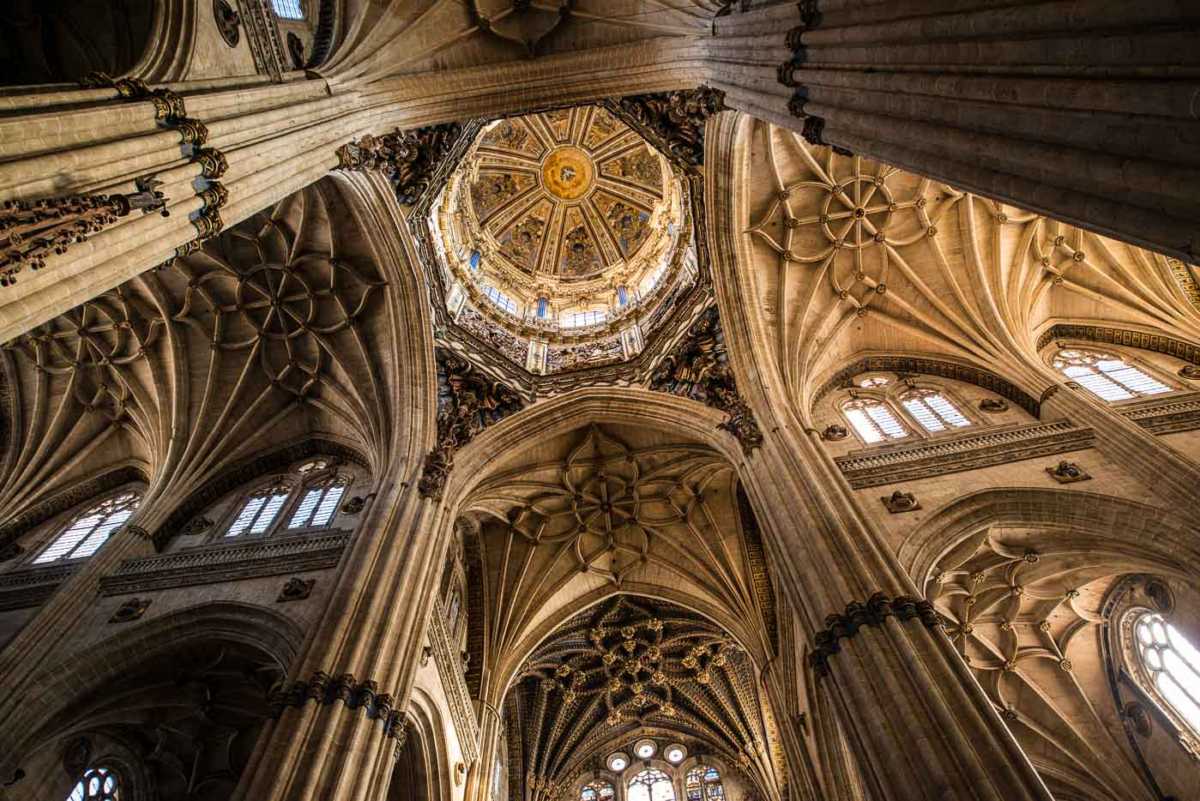
The Old Cathedral of Salamanca
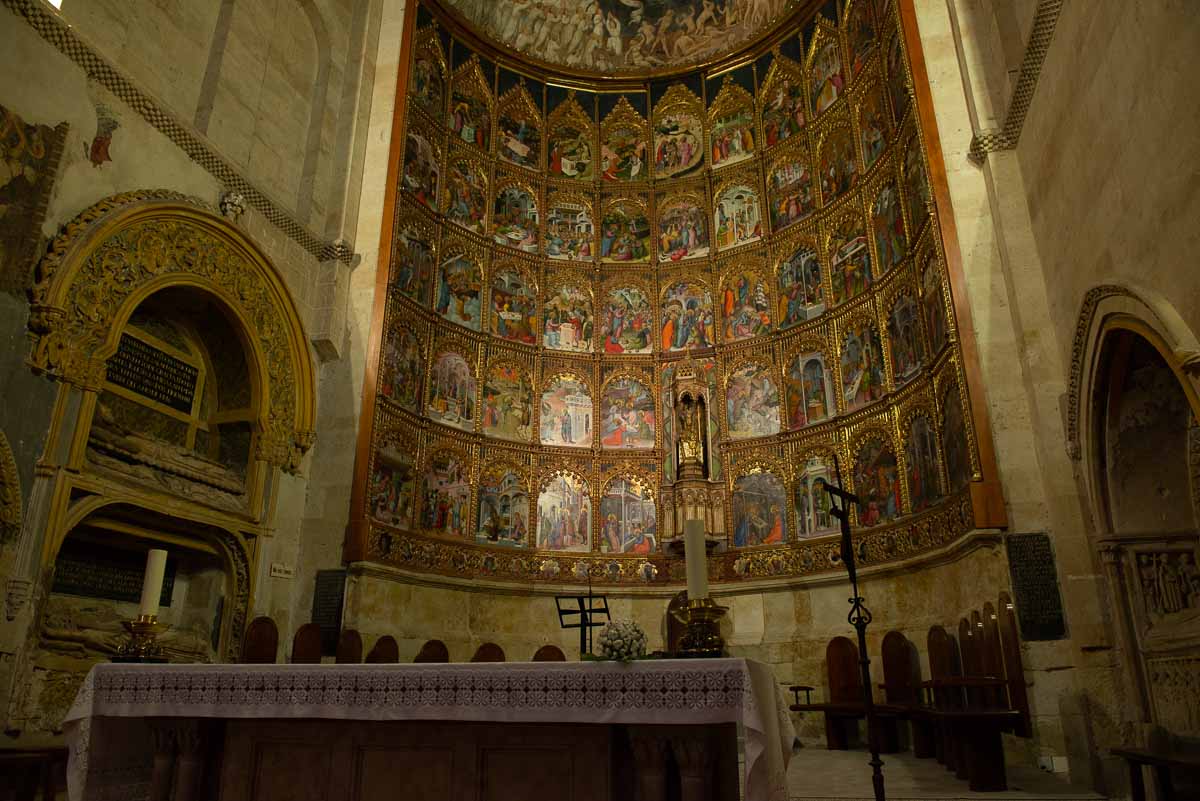
One of the real joys of exploring Salamanca is the discovery of the “old” Salamanca Cathedral adjacent to the new version. It was customary to raze older churches and build new ones on top as tastes changed, but luckily that didn’t happen in Salamanca (perhaps because the city was a center of learning?). So, you get to enjoy the old Romanesque style smaller church by just walking down a stairway in the back of the new cathedral.
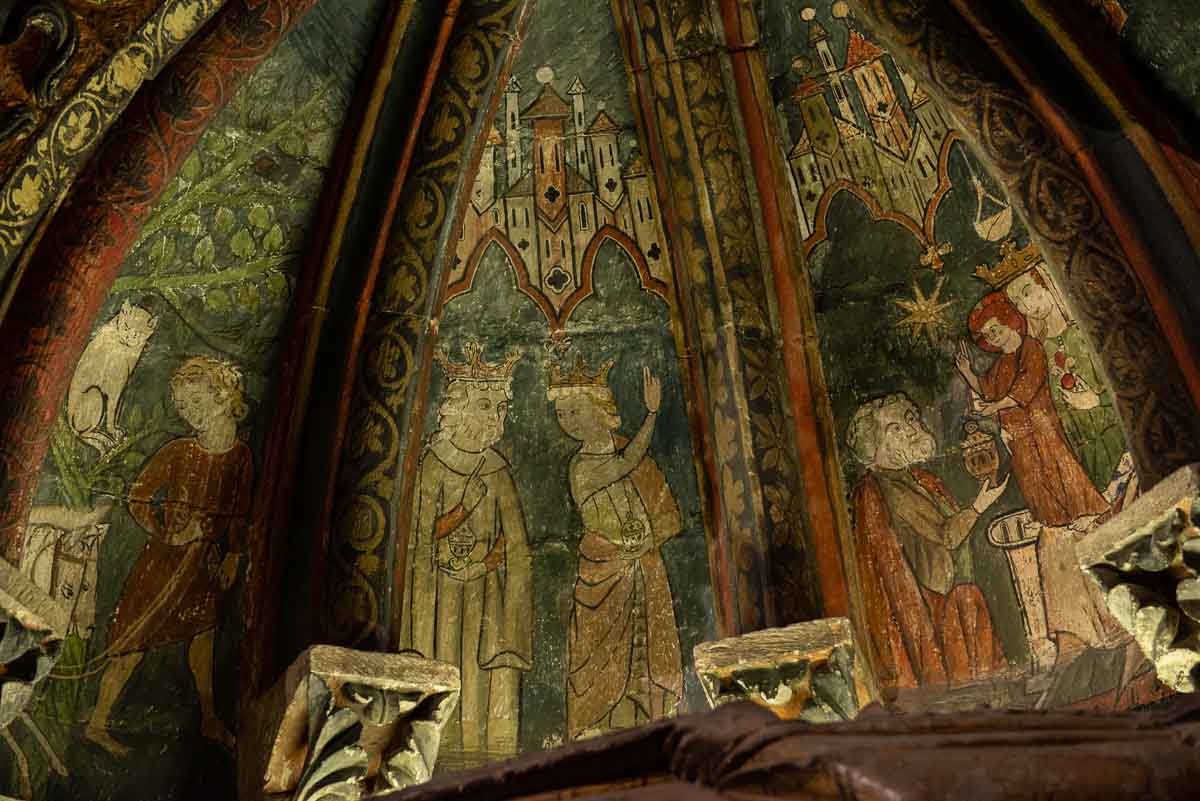
The apse paintings, unfortunately behind a rope so you can’t get as close as you might like, are lovely examples of earlier styles of more “flat” didactic storytelling. If you want to get a real sense of the art of the old cathedral, spend some time with the frescoes and carvings on some of the tombs which line the walls surrounding the altar and lead to the cloister.
The Cathedral of Toledo
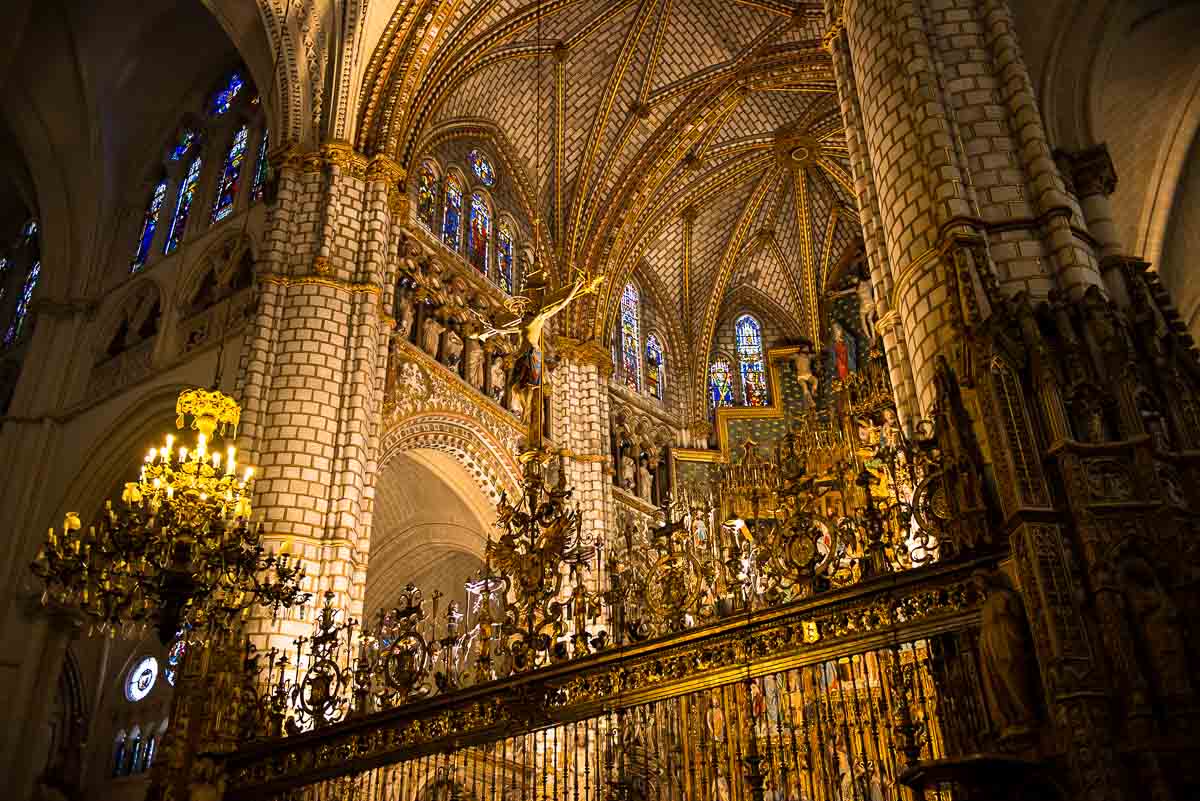
As in most Spanish cities, the cathedral is the city center. The Toledo Cathedral is no exception.
Toledo has always felt special to us. It was one of the first places we visited in Spain, and in a way, epitomizes the country. The Jewish and Moorish cultures that were so instrumental in the development of Spain are evident throughout the city.
The Jews and Muslims were tossed out of Spain or forcibly converted to Christianity by Fernando and Isabel after 1492. This, along with other significant events of that year, viz. the discovery of America by Columbus, and the final conquest of the Moors in Granada, is commemorated in an inscription on the back wall of the Cathedral of Toledo. The “winning” culture, Christianity, had the final say, and got to build the dominant monuments in every Spanish city. In Toledo and the other cities such as Sevilla, Granada, and Córdoba, Christians remodeled many palaces, mosques, and synagogues into Christian churches.
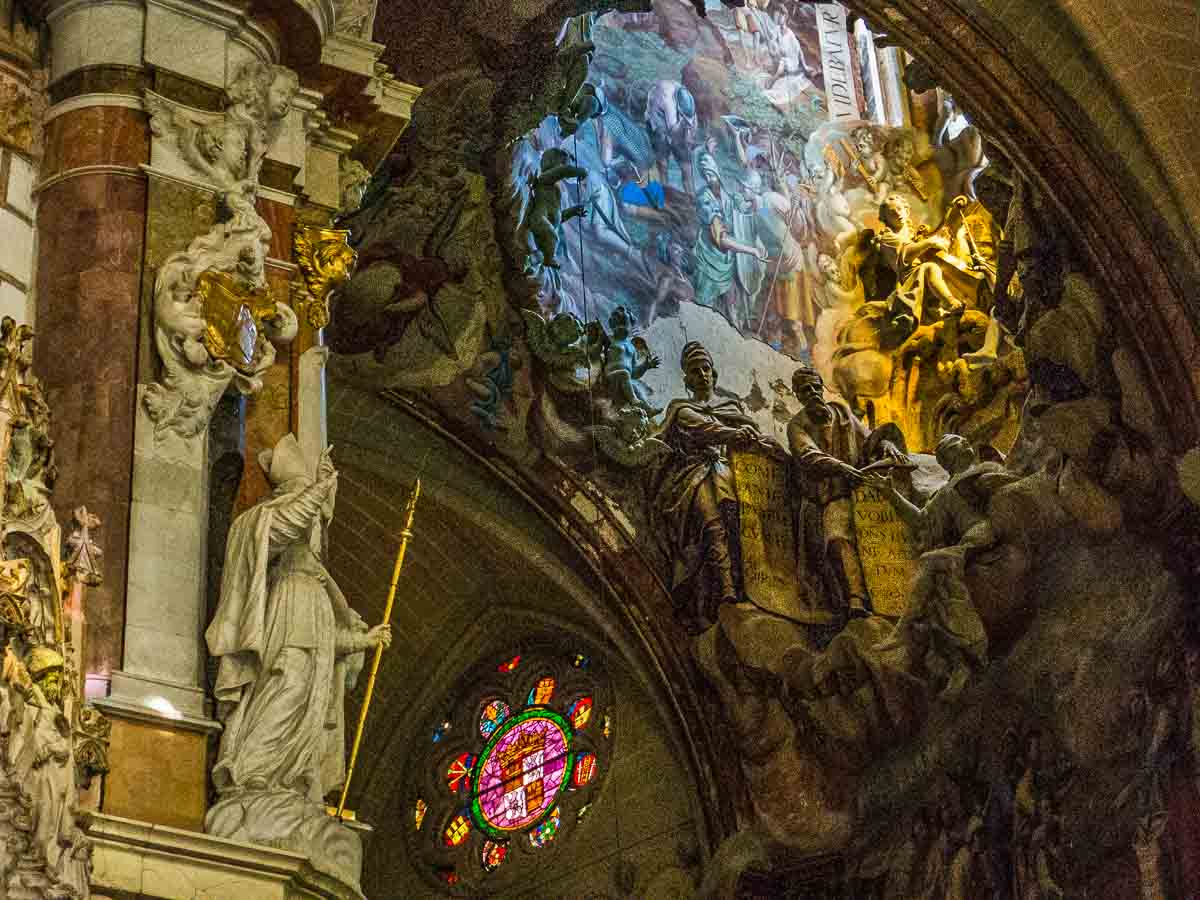
The Cathedral of Toledo exhibits many special features, including the spectacular golden altar overhung by an enormous crucifix and the unique transparente, a hole cut in the ceiling surrounded by sculpture and paintings done in a perspective that naturally leads your eye up to heaven. It’s a special effect found in no other church that I’m aware of.
The Cathedral of Avila
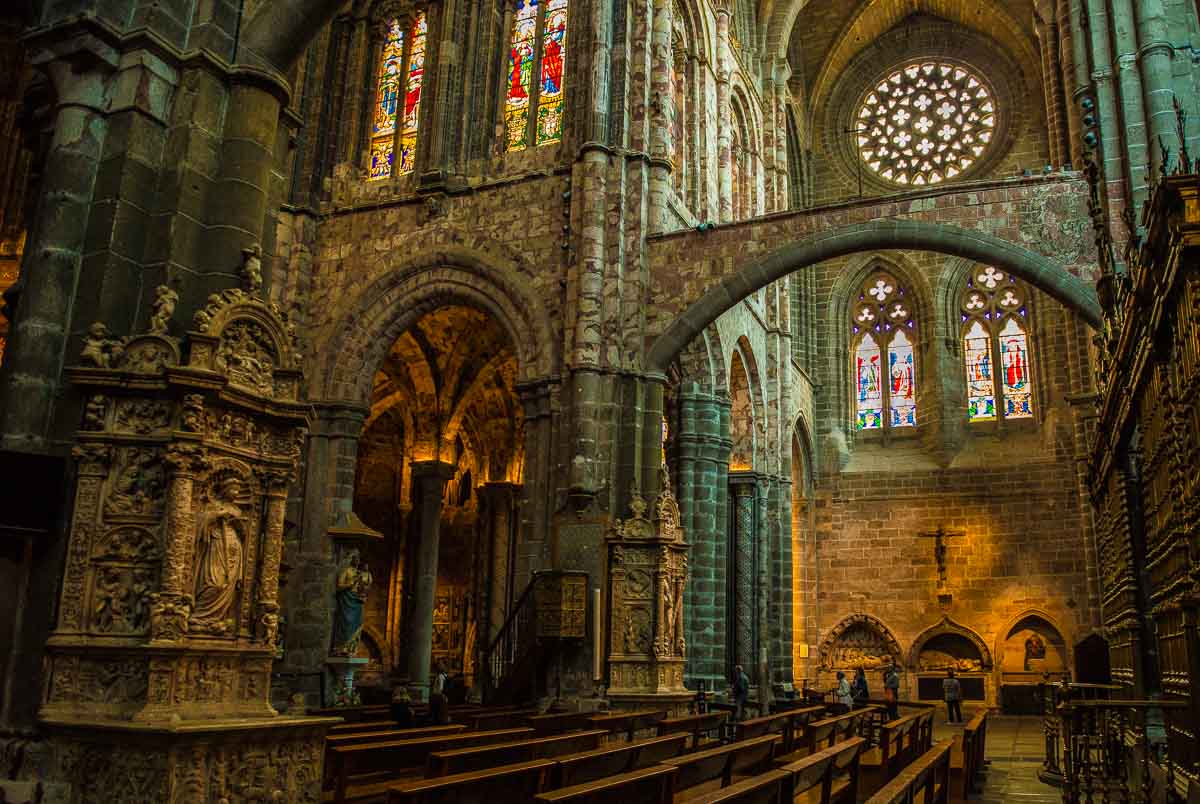
The stone of the apse and ambulatory of the Cathedral of Ávila , too, was unusual. Instead of the grey limestone or granite you usually find in medieval cathedrals–and what is used in the newer Gothic part of this one–the older Romanesque apse and transept of the Ávila cathedral features a locally quarried stone that is shot through with red coloring. This “bloodstone,” as it’s called, provides a beautiful warm tone to the otherwise thick and austere Romanesque construction.
The Ávila Cathedral is relatively uncontrived–especially when you consider its vastly more ornate Spanish sisters in Sevilla, Toledo, or Burgos. But it is a lot older, having been started in the 11th Century, right after Ávila was retaken from the Moors. The cathedral’s apse actually forms part of Ávila’s formidable defensive walls, so you can forgive a certain military simplicity.
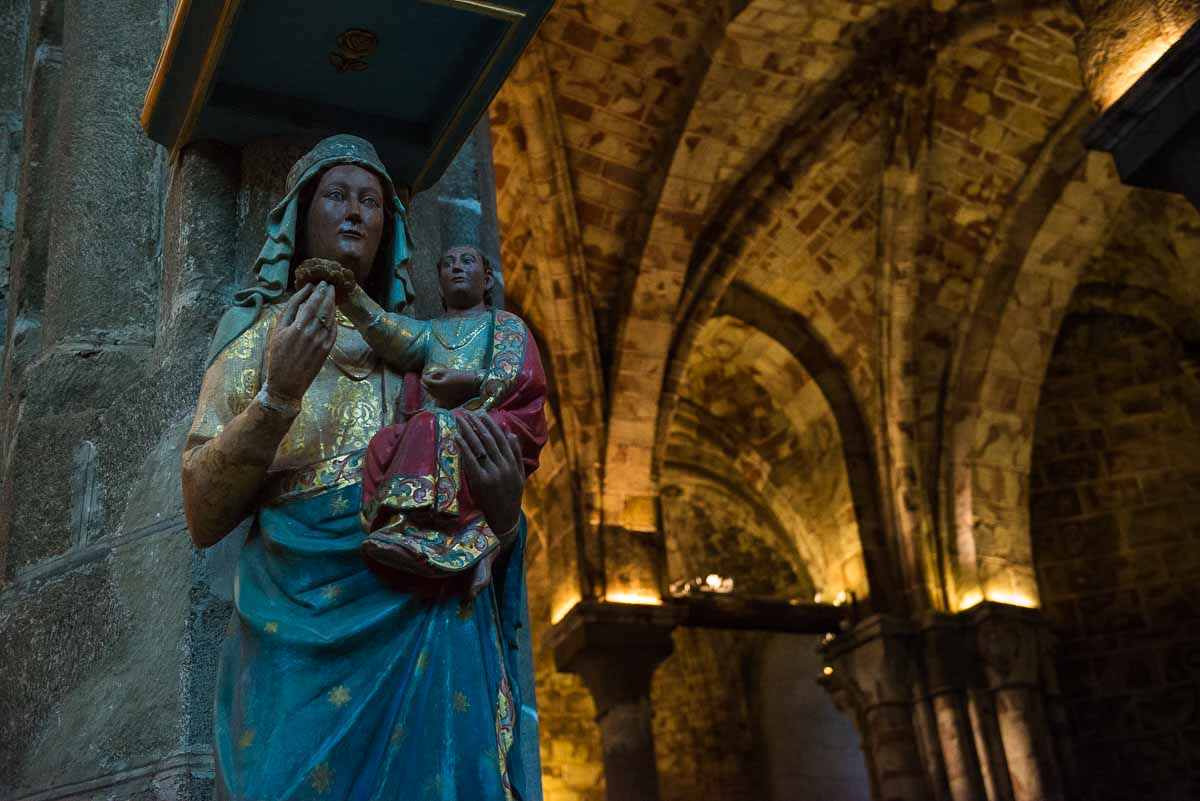
The Cathedral of León
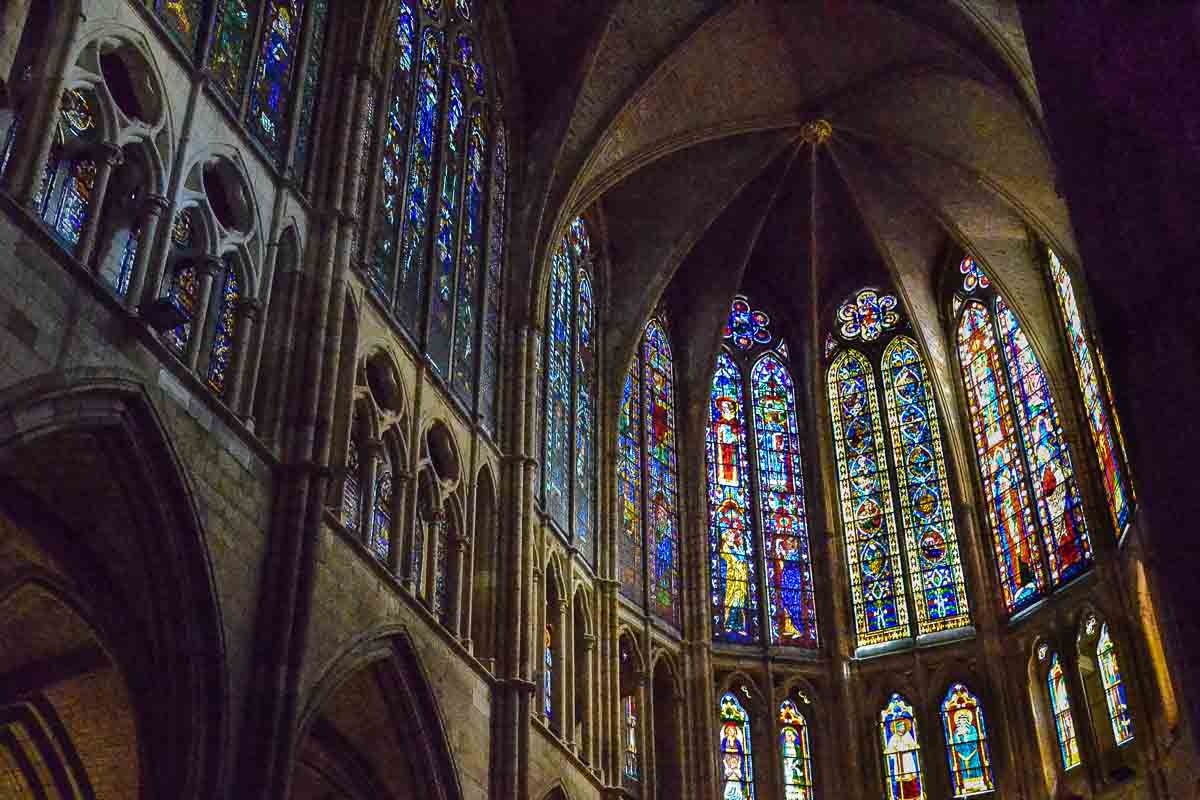
Of all the remarkable cathedrals in Spain, one of my favorites is León. The windows are the best of any Spanish church, and rival the Sainte Chapelle of Paris. One of the early problems with church architecture was how to keep the walls up if the thick walls were given up to provide for non load-bearing windows. The problems were solved beautifully in Leon.
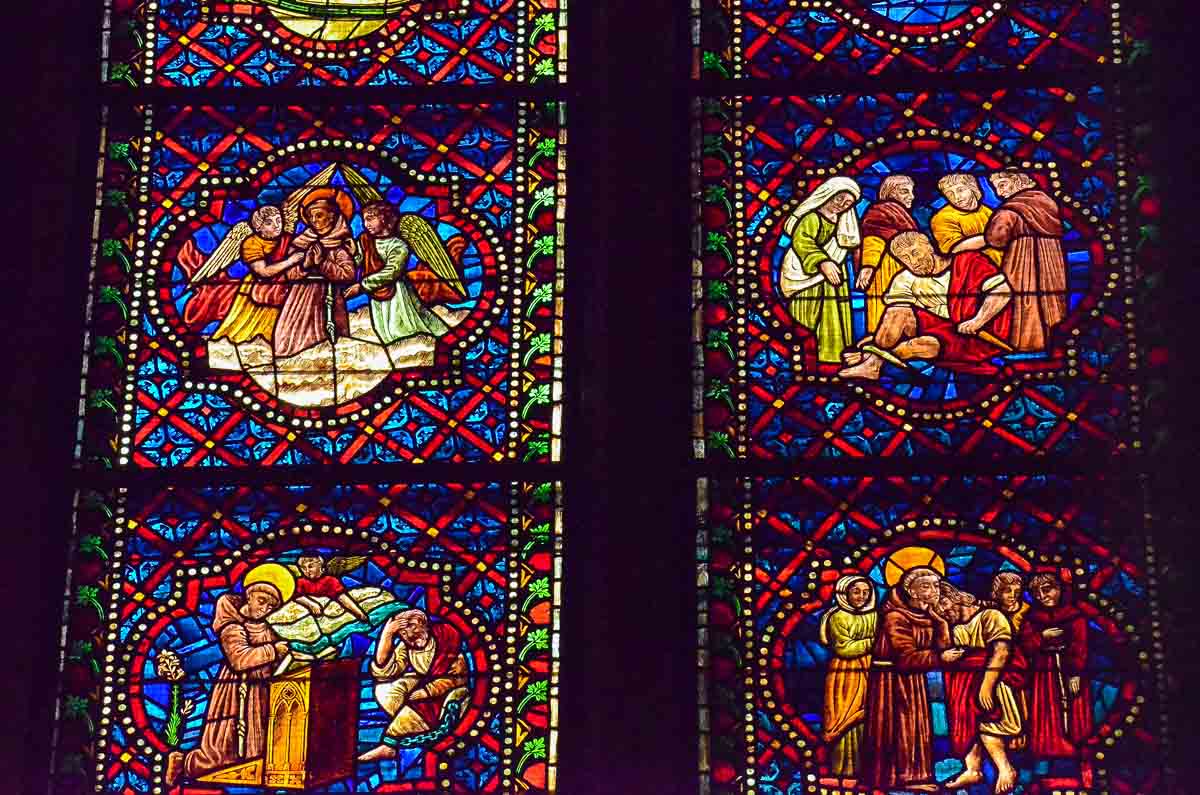
I’m not sure how they did it really. Flying buttresses were the usual solution to hold up the thin walls against the massive pressure of the roof, and those are in evidence in León. But, they’re sort of hidden from the outside by building them into a cloister on one side. Anyway, Leon Cathedral is a beautiful cathedral, inside and out.
The Cathedral of Granada
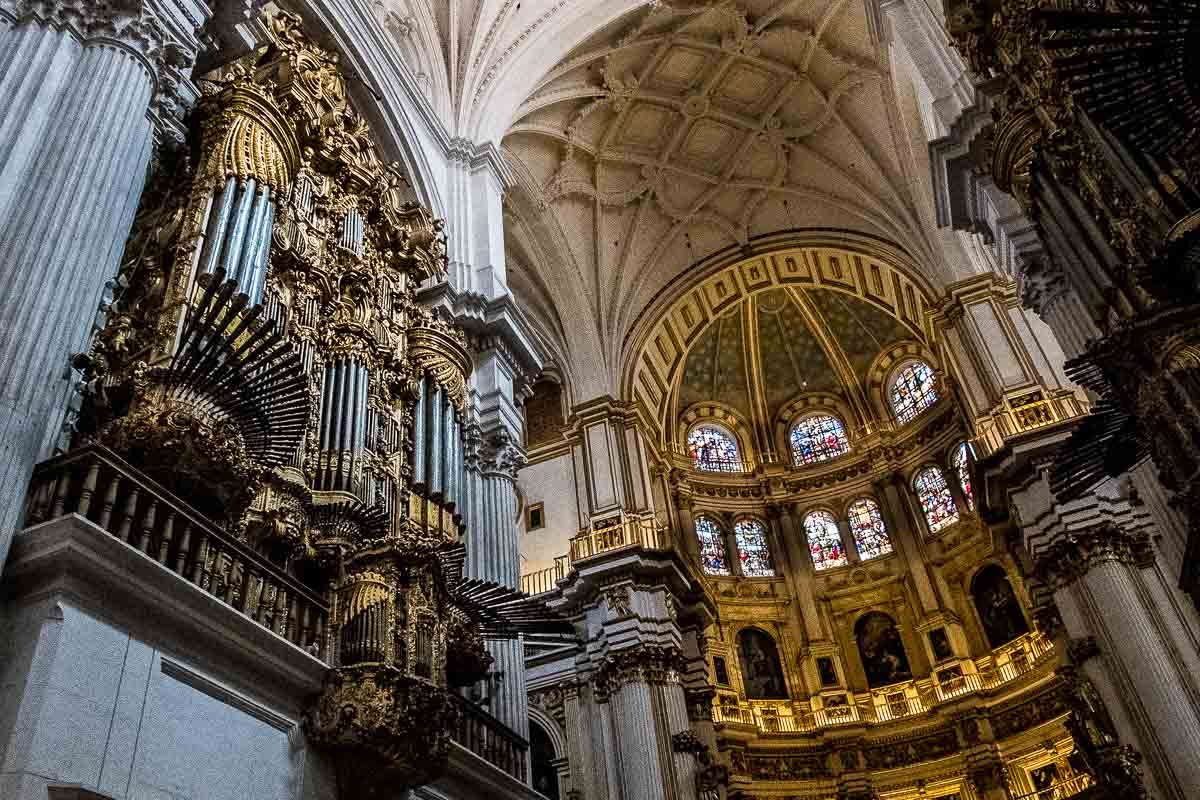
Because Granada was the last city to be captured from the Moors, it was the last of the major cities of Spain to get a cathedral. And, because it was almost the 16th Century when Christianity was reestablished here, styles had changed. No more Gothic, you see. There was now a Renaissance going on, and architects such as Michelangelo had changed the predominant style with such churches as St. Peter’s in Rome.
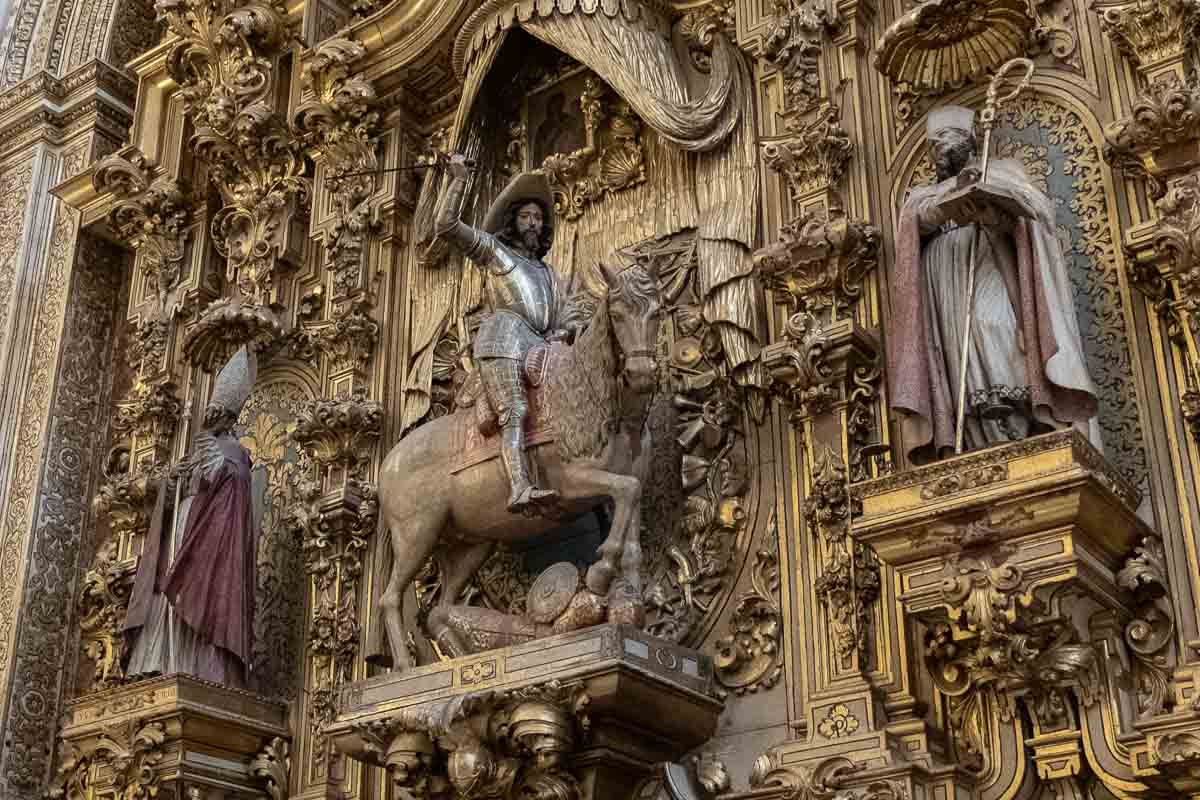
And so, you have what is basically a Renaissance style, which borrowed its simplicity from classical, not Gothic architecture. But the classically simple architecture was later tarted up with a lot of baroque decoration, such as this chapel decoration and ornate organ.
One feature of the Granada Cathedral worth noting is that it is the home of the tombs of the “Catholic Kings” Isabel and Fernando. Their tombs, in an adjacent chapel, are beautifully sculpted, but unfortunately no photography is allowed. If you go be sure to visit them. And also note the tomb of their daughter, Juana, known as La Loca, or The Mad. She had her tomb built larger and higher than that of her accomplished parents.
The Cathedral of Málaga
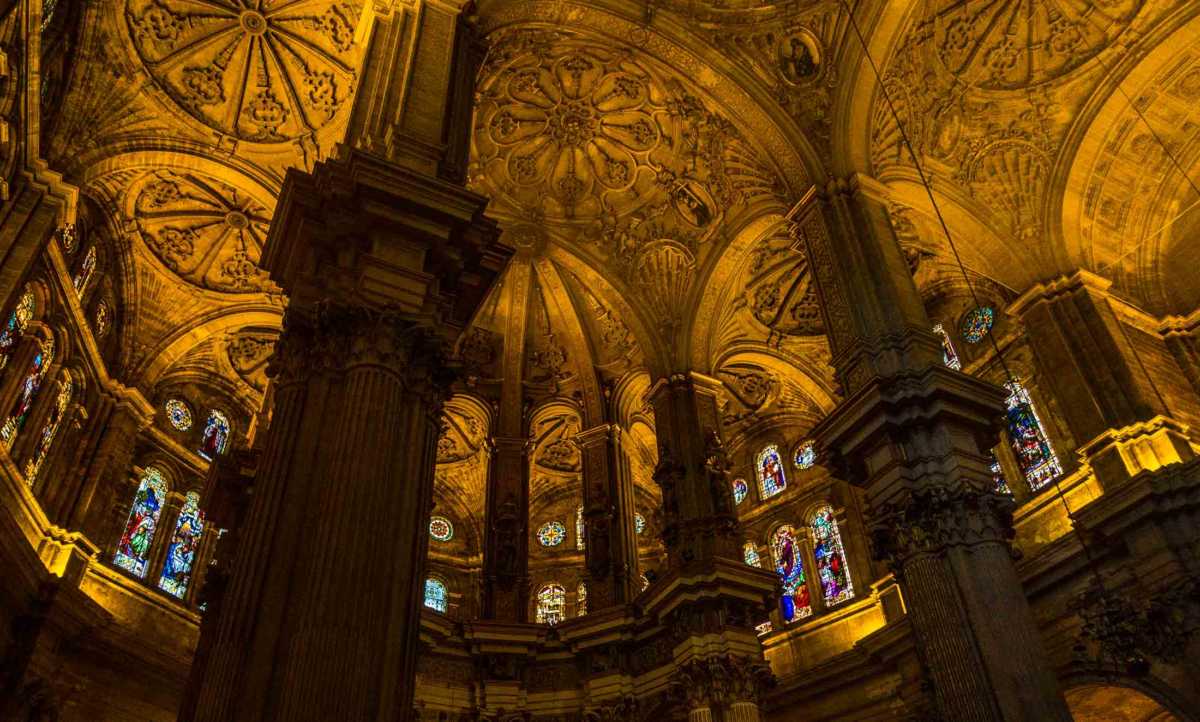
The Cathedral of Málaga is a late Renaissance masterpiece, which distinguishes it from most of the cathedrals of Spain, which were built at least a few hundred years earlier. Like Granada, the Málaga Cathedral was started in the early 1500s, soon after Málaga was recaptured from the Moors in 1487 (and after the final reconquest in 1492 of the last Moorish outpost of Granada, just up the road a piece).
There’s a lot of Baroque work in here too. But what really stands out is the massiveness of the columns and their exaggerated classical capitals. The columns themselves lend a real sense of weight and grandeur to the cathedral, but unfortunately also make it really difficult to get any sense of the sweep of the lovely windows of the apse. They are set back from the altar, which is surrounded by the columns, so there’s no way to really get a look at them all at once as they peek out from between the massive supports.
At any rate, the ceiling, as you can see, is quite lovely, and perhaps that makes up a bit for hiding the windows.
If you like the spectacular architecture and decoration of Spanish cathedrals, be sure to see our post about the Seven Wonders of Spain.
You can help yourself get ready for your own travels by reading our Get Started Planning Your Trip Now page.We love traveling–with the right gear. We’ve gathered a lot of the stuff we use to make travel more pleasant and efficient all on one page. Shop our Travel Past 50 Amazon page to find our favorite gear. If you purchase something from the store, Travel Past 50, as an Amazon affiliate, may receive a small commission at no extra charge to you. Thanks.
We never leave home without our travel insurance. Nor should you. Search for the travel insurance from Allianz that best meets your needs, whether it be an annual plan or a single trip.
You can see (and buy prints) of most of our travel photos in one place on this page.
Note: This post and other posts on TravelPast50.com may contain paid or affiliate advertising links.
Get all our travel tips delivered to your inbox
Subscribe to our email newsletter
Editor’s Note: It’s been a while since we’ve mentioned Chief Income Strategist Marc Lichtenfeld’s core investing system, the 10-11-12…
Copyright © 2024 Retiring & Happy. All rights reserved.








